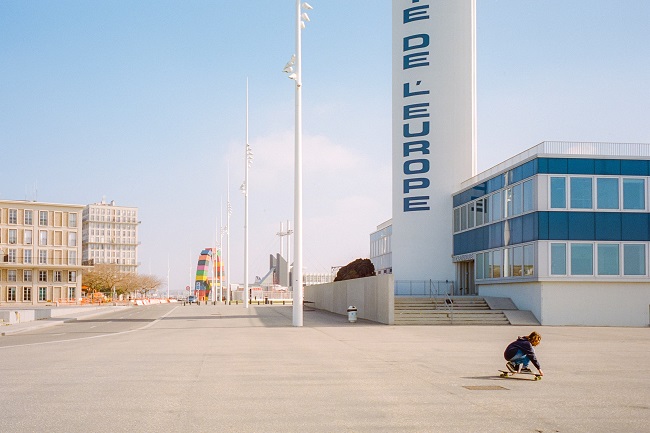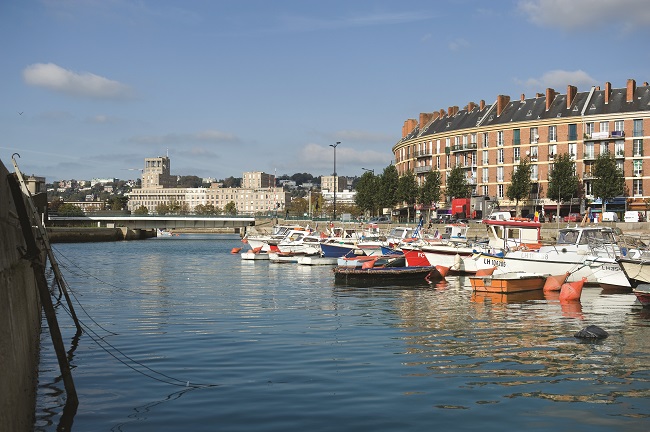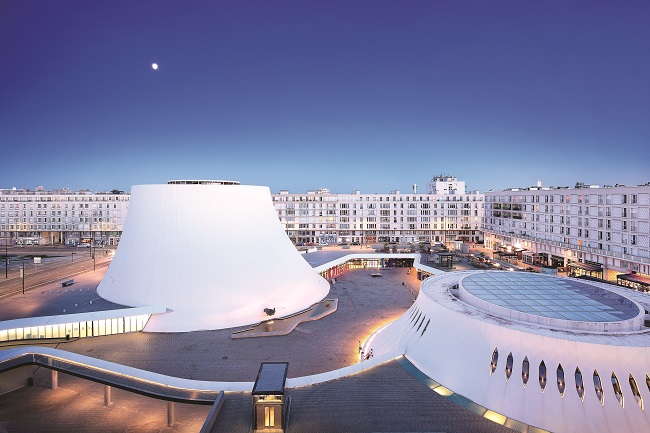City Breaks in France: Le Havre

The birthplace of the Impressionist movement, Le Havre, in the north of France, was radically rebuilt after World War II in the Modernist style, making its architecture unique amongst French cities.
As someone who likes flowing lines and tactile materials, I’ve never felt any great pull to visit a city of angular buildings created from concrete. But how wrong can you be? After years of skirting Le Havre as I passed through Normandy, I finally decided to see why this busy port had been singled out by UNESCO for World Heritage of Humanity status – and I’m happy to admit I’m now a convert.
The first port of Le Havre was created by order of François 1 in 1517, and quickly became an international trading hub for goods such as coffee, cotton and wood. By the mid-19th century, this bustling port was attracting a new clientele as a seaside resort, with transatlantic passengers also arriving by train from Paris en route to the Americas.
Le Havre was clearly on the up-and-up, but the good times came crashing down, literally, in September 1944 when 80% of the city was destroyed by Allied bombing raids during the Second World War. Rapid reconstruction became a social and strategic priority. Enter visionary architect Auguste Perret, affectionately known as the Master of Concrete. Between 1945 and 1964, Perret’s workshop numbered around 100 architects all working on his ambitious plan to create a new town of uniform buildings and green space. And nearly 80 years on, this coherent urban landscape is far from the clichéd idea of a ‘concrete jungle’. Dubbed ‘Manhattan-on-Sea’ by the post-war press, Le Havre–Porte Océane was awarded World Heritage status by UNESCO in 2005 as an outstanding example
of modern architecture.

Bassin du Roy ©Hilke Maunder – OTAH
But today, Le Havre is much more than a ‘new town’ of the 1950s. In 2019, the city and surrounding communes were brought together to form the Urban Community of Le Havre Seine Métropole. Covering the whole Pointe de Caux area, the community combines both the modern and historic city with 40 miles of coastline along the Seine estuary and the cliffs of the Alabaster Coast. It’s a fitting inclusion, given the area’s popularity with the Impressionist artists of the late 19th century, a movement that unwittingly began here.
In 1872, Claude Monet painted a picture of the harbour at Le Havre entitled ‘Impression, Sunrise’. Two years later, he displayed the canvas at a radical Paris exhibition alongside Degas and Pissarro, Renoir and Sisley. One unimpressed critic described the event as the ‘Exhibition of the Impressionists’ and the name stuck. The artists went from strength to strength and today Le Havre has one of the best collections of Impressionist art anywhere in France.

Town Hall square, Rue de Paris, and the Volcan from the Town Hall tower © Gillian Thornton
Le Havre’s towers
So where to head first? Towers always catch my eye, so I made first for St Joseph’s Church, visible from all over the city. Considered to be Perret’s masterpiece, the octagonal lantern tower, 107m high, is supported on a square base shaped as a Greek cross, a landmark for seafarers and city explorers alike. Step inside and it’s even more stunning, the geometric interior featuring 12,786 stained glass windows in jewel-like panels by Marguerite Huré.
My next stop was the tower of the Town Hall, built between 1952 and 1958 on the site of the original Town Hall. Today it stands at the point where the old and new towns meet. Take the lift to the 17th floor for a seagull’s eye view over tree-lined parks and straight streets of straight buildings towards the blue of the Seine estuary and city docks. Between Place de l’Hôtel de Ville and the sea, look out for a curvaceous conical structure with a flat top, Le Volcan. This concrete ‘volcano’, which was completed in 1982, is Le Havre’s cultural centre and was designed by Oscar Niemeyer, a follower of Le Corbusier. Finished in concrete and painted white, its free-flowing curves are an arresting contrast to the straight lines around it. Step inside to experience the ramps and staircases that interact seamlessly with the open space.
Auguste Perret put as much thought into the interior of his buildings as the exterior. In 1947, he opened show flats so that local people who had lost their homes in the bombing could see their bright, new accommodation, full of space, calm and sunlight. And today L’Appartement Témoin Perret has been recreated within one of the first blocks rebuilt in Le Havre, a fascinating immersion in social time travel.

Le Volcan – La Colombe Niemeyer © Alexandre Rety – LHENT
Art and architecture
Walk around Le Havre and you’ll spot many eye-catching views: Porte Océane, a dramatic ‘city gate’ of buildings between the town and the beach; Avenue Foch, Perret’s ‘Champs-Elysées’ between the Town Hall and the sea; and the botanical garden of Saint-Roch with its ponds and bandstand. Head south along Rue de Paris from the Perret Show Flat and you pass two remaining relics of the historic town, the cathedral and the Natural History Museum. Both restored by Perret, they are important symbols of survival against the odds.
At the end of Rue de Paris stands one of my favourite buildings, the André Malraux Museum of Modern Art, or MuMa. Packed with works by all the leading Impressionist and Fauvist painters, the museum was inaugurated in 1961 and takes the form of a cube of glass facing the sea and flooded with natural light. I could stand for hours in front of the seascapes created by Honfleur artist Eugène Boudin, an inspiration to the young Monet and the Impressionist painters who followed him.

The Saint-François church survived the bombings ©OTAH
Old meets new
Saint-François, one of Le Havre’s oldest districts. Here reminders of the pre-war years are integrated into post-war buildings built with bricks and slate on a concrete framework. Stop off to visit the fish market on Quai de l’Île and the Maison de l’Armateur, an 18th-century ship-owner’s mansion.
Visit the area between November 1 and 5 this year and the waterfront will be buzzing with boats, as Le Havre celebrates the 30th anniversary of the Transat Jacques Vabre, a major international sailing event that was created in 1993 by the city of Le Havre and the Jacques Vabre coffee brand.
Longest of all the double-handed transatlantic races, the Transat takes place every other year, and for 2023, more than 60 sailing boats will retrace the historic coffee route between France’s first coffee-trading port and the coffee plantations of Fort-de-France in Martinique. Monet, one suspects, would have loved it.
Lead photo credit : Le Havre is not the drab 'concrete jungle' one might imagine © Paul François Gapais on Unsplash
Share to: Facebook Twitter LinkedIn Email
More in city breaks, city guide, le havre, Normandy
Leave a reply
Your email address will not be published. Required fields are marked *



